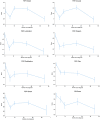Sexual function and satisfaction in young women with breast cancer: a 5-year prospective study
- PMID: 39504463
- PMCID: PMC11660426
- DOI: 10.1093/jncics/pkae111
Sexual function and satisfaction in young women with breast cancer: a 5-year prospective study
Abstract
Background: Young women with breast cancer (YWBC) face unique challenges that can affect their sexual health. This study aimed to identify factors associated with sexual activity, function, and satisfaction in YWBC up to 5 years postdiagnosis.
Methods: We conducted a prospective cohort study of 474 women 40 years of age or younger diagnosed with nonmetastatic breast cancer in Mexico. Sexual function and satisfaction were assessed using the Female Sexual Function Index and the Sexual Satisfaction Inventory, respectively. Factors associated with sexual health outcomes were examined using mixed-effects models.
Results: The prevalence of sexual dysfunction increased from 33.6% at baseline to 52.9% at 4-5 years postdiagnosis. Factors associated with worse sexual function included older age (mean predicted FSFI score = -1.35, P = .037), treatment-induced amenorrhea (-2.86, P < .001), depression (-4.11, P < .001), and anxiety (-2.13, P < .001). Lower sexual satisfaction was associated with lower educational attainment (mean predicted SSI score = -5.61, P = .002), being single (-6.41, P < .001), treatment-induced amenorrhea (-3.76, P = .004), bilateral oophorectomy (-8.21, P = .017), depression (-11.29, P < .001), and anxiety (-7.50, P < .001). Quality of life, body image, and systemic therapy side effects significantly affected both outcomes. Three distinct trajectories of sexual function were identified: high (62.2%), intermediate (24.3%), and markedly declining (13.5%). Four trajectories of sexual satisfaction were found, ranging from intermediate-to-high (57.3%) to progressively worsening (27.5%).
Conclusion: Sexual dysfunction is prevalent and persistent among YWBC. Multiple biological, psychological, and social factors influence sexual health outcomes in this population. These findings highlight the importance of routine screening and tailored interventions to address the sexual health of YWBC throughout survivorship.
© The Author(s) 2024. Published by Oxford University Press.
Conflict of interest statement
C.V.G.: Consulting or Advisory Role—Astra; Speakers’ Bureau—Lilly, Novartis, Astra, MSD; Research Funding—Astra, Pfizer, Gilead; Travel, Accommodations, Expenses—Pfizer, MSD. No other potential conflicts of interest were reported.
Figures





References
MeSH terms
LinkOut - more resources
Full Text Sources
Medical
